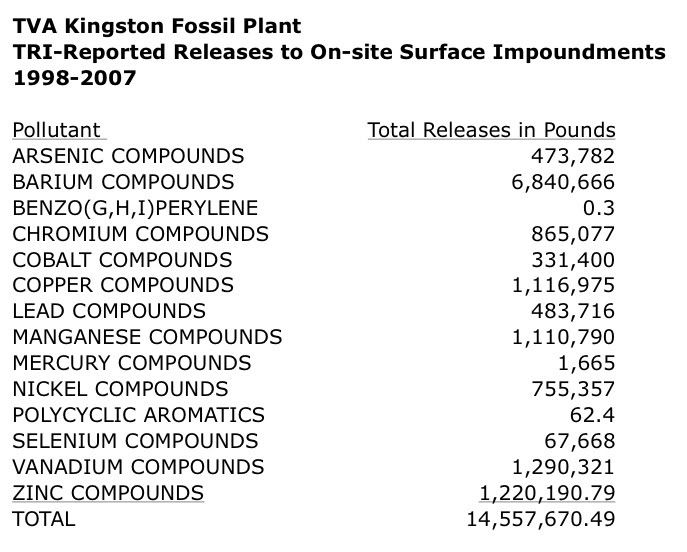(This story was originally posted at Facing South, the online magazine of the Institute for Southern Studies.)
Earlier this week, the Southern Alliance for Clean Energy called on the Tennessee Valley Authority to release its testing data showing what was in the 1.1 billion gallons of coal ash that spilled last week from the failed impoundment at its Kingston power plant in Roane County.
The company has not yet done that, with TVA President and CEO Tom Kilgore saying it was focusing instead on cleanup.
"We know they have that data," said SACE Executive Director Stephen Smith. "Yet here we are eight days into this event and we still don't have it."
It's important for local residents, cleanup workers and others who come in contact with the spilled coal ash to have some sense of what's in it so they can adequately protect themselves. It's especially critical for the rural dwellers near the spill who rely on private wells for their drinking water.
In order to get some sense of what's in the ash, the Institute for Southern Studies examined the facility's Toxics Release Inventories filed with the Environmental Protection Agency from 2006, the most recent available on EPA's TRI website, back to 1998, the first year that coal-fired power plants reported their emissions under TRI. We also factored in the 2007 TRI emissions data posted on the TVA's own website. Here is what we found:

For a year-by-year breakdown of the releases, click here.
It should be noted that here are limits to the TRI data. For one thing, it is self-reported by the company with no independent verification. In addition, the reports look at only select chemicals, excluding some pollutants found in coal such as radioactive elements. And the data only goes back so far, while the Kingston plant has been in operation since 1955. But the TRI data does give a sense of some chemicals of concern present in the ash and thus the potential health risks.
It turns out that the potential health risks from the spilled ash are clearly considerable. The top reported pollutant in the ash by volume is barium, which when ingested in drinking water can cause acute gastrointestinal disturbances and muscle weakness as well as kidney damage over time. Vanadium, another main ingredient in the ash, has been linked to respiratory problems, birth defects, and kidney and liver damage.
The coal ash also contains high levels of known human carcinogens including arsenic, chromium, mercury, nickel and polycyclic aromatic compounds, as well as suspected carcinogens such as lead and cobalt. Mercury and lead are also nervous system toxicants that can cause developmental problems, and a number of the chemicals in the ash have been linked to reproductive problems.
"We have been frustrated by TVA's public statements minimizing the seriousness of this massive release and withholding information," said Smith, whose group served legal notices today announcing its intent to bring legal action against TVA under the federal Clean Water Act and the Resource Conservation and Recovery Act. "If legal action is the means necessary to ensure that TVA is open and transparent about this disaster moving forward, then we will use it."


